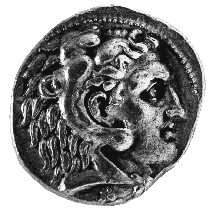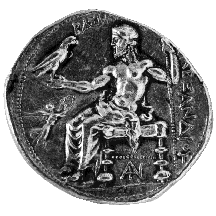



(42) Tarsos, Cilicia - AR tetradrachm, 323-317 B.C., 17.17 g.
(inv. 91.051).
Obverse: Head of Herakles in lionskin cap r.
Reverse: Zeus enthroned l., holding eagle in r. and scepter
in l.; flying Nike with wreath in l. field; monogram beneath throne; in
exergue, ![]() ;
; ![]()
![]() : of King Alexander.
: of King Alexander.
Provenance: Münzen und Medaillen, 1971.
Bibliography: M.J. Price, The Coinage in the Name of
Alexander and Philip Arrhidaeus
(Zurich and London 1991) 376 no. 304, pl. LXXXVI.
The new silver tetradrachms of Alexander the Great were issued on the authoritative
Attic weight standard, and they soon replaced the Athenian "owl"
tetradrachms (see no. 30) as the most widely circulated
coins in the ancient world. When Alexander died in 323 B.C., his empire
was divided among his generals and associates, who for many years fought
among themselves to maintain and extend their respective kingdoms. But Alexander's
successors and the cities he conquered continued to issue coins in his name,
undoubtedly because their connection with Alexander made them immediately
recognizable as good money. These posthumous coins were issued side by side
with the cities' own coins and with the coins issued in the names of Alexander's
successors.
The posthumous coins closely resembled Alexander's issues, but with minor
stylistic changes
and different symbols. This tetradrachm was issued in Tarsos, a strategic
Hellenized city in Cilicia, which was captured by Alexander in 333 B.C.
Its marks include the Nike flying in the left field and the monogram beneath
the throne on the reverse. The coin also illustrates an important feature
of many of the posthumous issues: Alexander is given the title basileus
or king. The title may have been used as early as 329 B.C., but it became
common in the posthumous issues, following the tradition of Alexander's
successors who soon put the title on their own coins (see nos. 43,
45, 49, 54). And although
the head of Herakles on the obverse of these coins continues unchanged,
there can be little doubt that the head was now regarded as a portrait of
Alexander, since by this time his successors, following Persian practice,
had adopted the tradition of putting their own images on their coins.
K.L.R.



All contents copyright (c) 1996.
Lawrence University
All rights reserved.